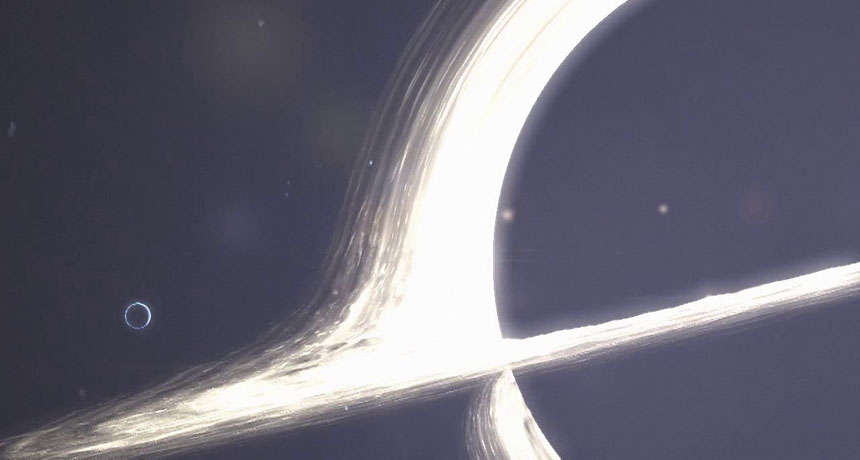Spinning black holes may ‘sing’ during a collision
The massive black hole in ‘Interstellar’ would create unique gravity-wave signal when gobbling a smaller partner

The spinning black hole in the movie Interstellar, illustrated in this image, isn’t real. But if it were, it would create a unique gravitational wave signature when it swallowed a companion.
ensouensou/Vimeo
Share this:
- Share via email (Opens in new window) Email
- Click to share on Facebook (Opens in new window) Facebook
- Click to share on X (Opens in new window) X
- Click to share on Pinterest (Opens in new window) Pinterest
- Click to share on Reddit (Opens in new window) Reddit
- Share to Google Classroom (Opens in new window) Google Classroom
- Click to print (Opens in new window) Print
SALT LAKE CITY, Utah — When black holes collide, they create gravitational waves. These gravity waves aren’t exactly like waves of water or light. They are instead tiny ripples in the fabric of space. Astronomers expect to record these ripples as a kind of “chirp,” similar to the sound a bird might make. But not all colliding black holes chirp, scientists now say. Some may prefer to sing.
Those that sing will be the ones that spin extremely fast. The spinning black hole featured in the 2014 film Interstellar is a perfect example. It is called Gargantua, and rightly so. It is huge. It would have had a mass 100 million times as great as that of our sun. And it whirled about its axis at breakneck speeds. That’s according to the calculations of Kip Thorne. He is a physicist at Caltech who served as scientific consultant for Interstellar.
Such mass and speed would explain the extreme slowdown of time — what scientists call a time dilation. But it would be seen only on the world where the film’s planet hunters had landed. In one hour there, seven hours would have elapsed on Earth. This phenomenon is predicted by Albert Einstein’s theory of general relativity. That theory is a set of mathematical expressions that define gravity as the warping of space and time. It also helped astronomers capture the “chirp” of gravitational waves from two colliding black holes. The discovery was announced in February 2016. This was the first detection of gravity waves.
A “chirp” is the standard signal of merging black holes. It gets its name from the changes that happen to gravity waves created as the black holes spiral inward. These changes are seen in the frequency and amplitude of the waves. Frequency is the number of waves that occur over a particular period of time. Amplitude describes the height of those waves. Both increase as the black holes get closer. And both can be represented as sound waves. In sound waves, the frequency determines a note’s pitch, and the amplitude determines its volume. When scientists convert gravity waves to sound waves, they get what sounds like a bird’s chirp.
But if a rapidly spinning black hole merges with a companion, it would produce a “completely different gravitational wave signature,” said Niels Warburton. He is a physicist at the Massachusetts Institute of Technology, or MIT, in Cambridge. He spoke April 18 at a meeting, here, of the American Physical Society. He also coauthored a related paper posted online at arXiv.org on March 3.
Warburton and his colleagues wanted to know what the gravity-wave signature from a merger with a black hole spinning at nearly full tilt would be. Their calculations show that instead of a chirp, the waves would maintain a constant pitch, but slowly fade away. This would sound like a singer holding a note.
“It was certainly very unexpected to see something that didn’t chirp,” says Jolyon Bloomfield. He is a physicist and a lecturer at MIT. He was not involved with the research but says it is interesting work. “It shows that the chirp actually goes away — something else is happening here.”
Waiting to see Gargantua-size singers
In his talk, Warburton said that gravity wave detectors might be able to observe the unique signal from collisions of of spinning black holes. The Advanced Laser Interferometer Gravitational-Wave Observatory, or LIGO, made the first detection of gravity waves this past February. LIGO can’t observe the mergers of black holes as massive as Gargantua, Warburton said. But smaller spinning black holes would produce a similar effect, which could be observed.
Next-generation gravity-wave observatories, however, may be able to detect the songs of extremely large, spinning black holes. One of these upcoming observatories is called the Evolved Laser Interferometer Space Antenna, or eLISA. Plans call for eLISA to measure gravitational waves from space beginning in 2034. Singing gargantuan-black-hole collisions should be “definitely detectable with eLISA,” Warburton said.
These kinds of detections would be exciting for exploring extreme physics. Spinning black holes are “really interesting from a fundamental physics point of view,” says Samuel Gralla. He is a physicist at the University of Arizona in Tucson. He also was a coauthor of the new paper.
Black holes can spin faster and faster as they suck in matter, he explains. But there’s a limit to how fast they can go. That’s because at the center of a black hole is a singularity, or region of infinite density. It is hidden by an event horizon — the surface beyond which nothing can escape a black hole’s greedy pull. If the black hole twirls too fast, then the singularity is exposed. This is known as a “naked singularity.” Scientists think it is impossible to reach because the known laws of physics would break down.
The calculations made by Gralla, Warburton and their team showed that black-hole mergers sing when the larger black hole is spinning at just below its limit. That would be when it spins at 99.99 percent of its maximum speed. This makes the detection of singing black holes an enticing prospect for understanding physics at its extremes.







